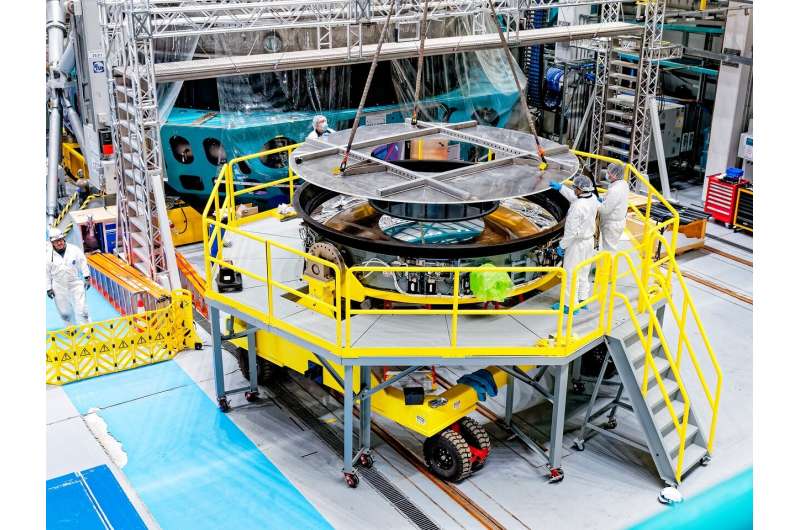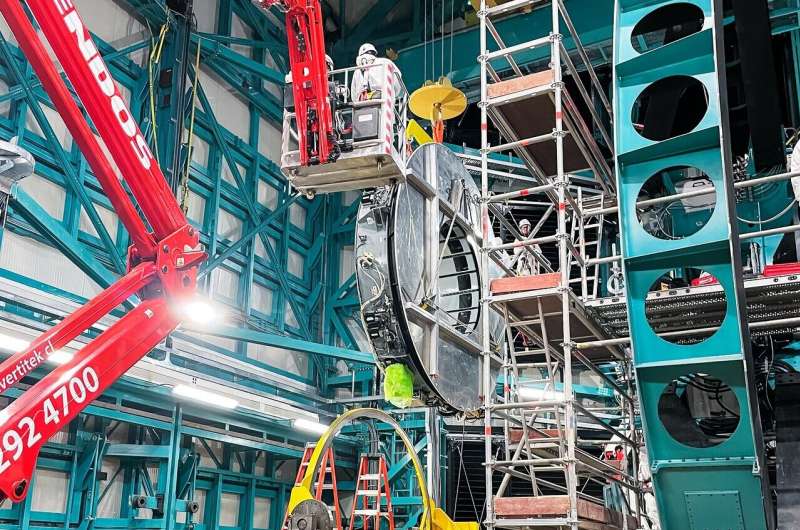This article has been reviewed according to Science X's editorial process and policies. Editors have highlighted the following attributes while ensuring the content's credibility:
fact-checked
proofread
Rubin Observatory's 3.5-meter secondary mirror installed

Vera C. Rubin Observatory's 3.5-meter secondary mirror has been installed on the Simonyi Survey Telescope on Cerro Pachón in Chile. The glass mirror—made by Corning Advanced Optics and polished by L3Harris Technologies—is the first permanent component of the telescope's state-of-the-art, wide-field optical system to be installed and will soon contribute to a better understanding of our universe.
The summit team at the NSF–DOE Vera C. Rubin Observatory in Chile has installed the 3.5-meter glass secondary mirror assembly on the Simonyi Survey Telescope.
This achievement marks the successful integration of the first permanent component of the telescope's optical system, which also includes an 8.4-meter primary/tertiary mirror and the LSST Camera—the largest digital camera in the world. Rubin Observatory is poised to kick off a new era in astronomy and astrophysics with the 10-year Legacy Survey of Space and Time (LSST), beginning in 2025.
The installation of the complete mirror assembly was the culmination of many years of hard work and planning by teams in the U.S. and in Chile. After fabrication and polishing, the glass blank and the mirror cell assembly components were shipped to Chile in 2018 and stored inside the observatory while work continued on the telescope mount.
The secondary mirror was coated with protected silver at Rubin Observatory in 2019 and integrated with the mirror cell in early July 2024 before being installed on the telescope.
"Working with the mirror again after five years is extremely exciting because it really feels like we're in the home stretch," said Sandrine Thomas, Deputy Director for Rubin Observatory Construction, "Now we have glass on the telescope, which brings us a thrilling step closer to revolutionary science with Rubin."
At just under four meters in diameter, Rubin's secondary mirror is one of the largest convex mirrors ever made. The 10-centimeter-thick monolithic mirror blank was manufactured by Corning Advanced Optics in Canton, New York, using Corning ULE Glass (Ultra-Low Expansion Glass).

"Corning is proud of our nearly 20-year collaboration with the Rubin Observatory team," said Claude Echahamian, VP & GM Corning Advanced Optics.
"As a result, Corning's cutting-edge ULE mirror blank for the Simonyi Survey Telescope will help to enable crystal clear views of deep space, revealing millions of previously unknown solar system objects with more detail than ever before."
Following delivery in 2009, the mirror blank was stored for five years at Harvard University in Cambridge, MA before being polished and finished at L3Harris Technologies in Rochester, New York. L3Harris used novel measurement techniques in the polishing process to manage such a large precision convex surface.
L3Harris also designed and built the secondary mirror cell assembly, which consists of a stiff steel mounting plate, 72 axial and six tangent actuators (that support and control the shape of the thin mirror under gravity), the mirror cell electronics and sensors, a thermal control system, and the mirror control system.
"Our 55-year legacy of designing and constructing high-end optical systems for space and ground continues with the world's largest active secondary mirror system built for Rubin Observatory," said Charles Clarkson, Vice President and General Manager, Imaging Systems, Space and Airborne Systems, L3Harris.
"With this milestone, we are closer to pushing scientific frontiers and charting the universe like never before, and we look forward to the science that will be discovered."
To install the mirror assembly onto the telescope mount, the Rubin summit team used a specialized cart to rotate the mirror assembly to a vertical position.They then lifted the assembly off of the cart and onto the telescope mount while maintaining active system control to prevent adding stress to the glass.
After bolting the secondary mirror assembly in place, the summit team connected the mirror cell to the electronics cabinet on the telescope mount and reactivated the mirror's software control system.
In the coming weeks, the Rubin team will re-install the Commissioning Camera, a much smaller version of the LSST Camera, that will be used to conduct a variety of test campaigns on the optical system including both mirrors.
The team will also now focus on preparing the primary mirror assembly for telescope integration in August, and the LSST Camera for installation on the telescope later this year.
Provided by Vera C. Rubin Observatory





















